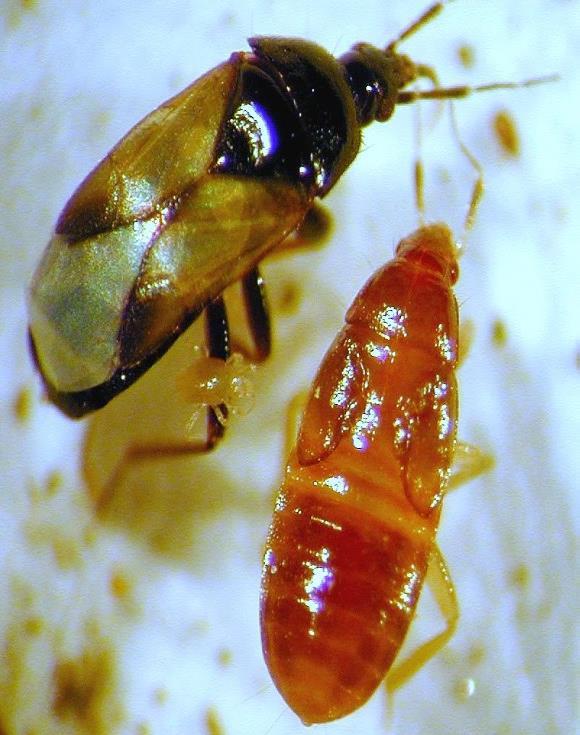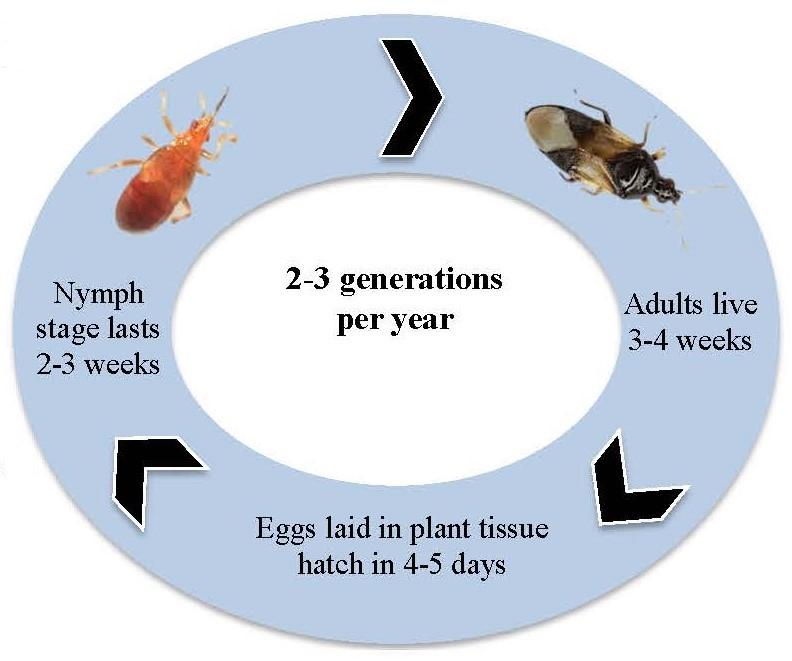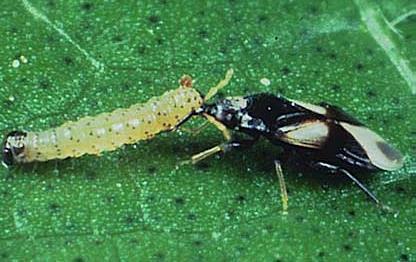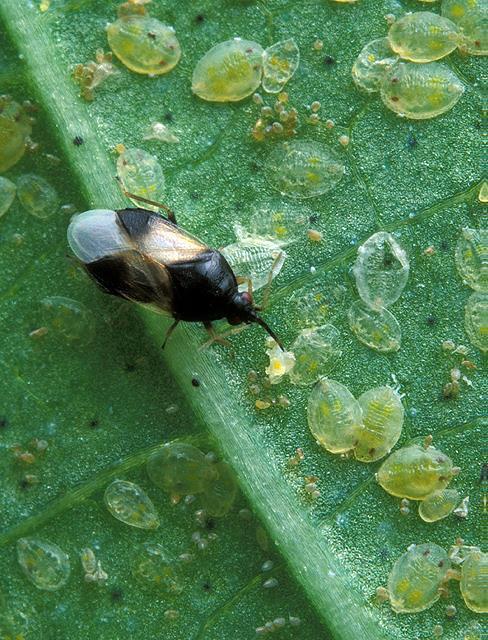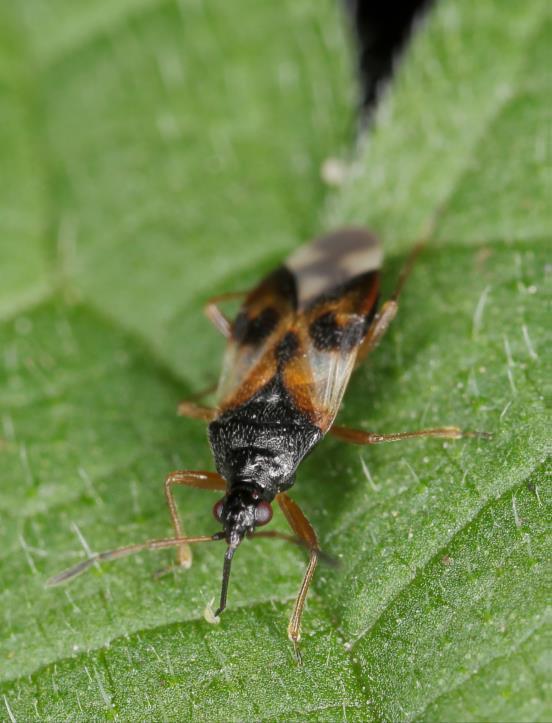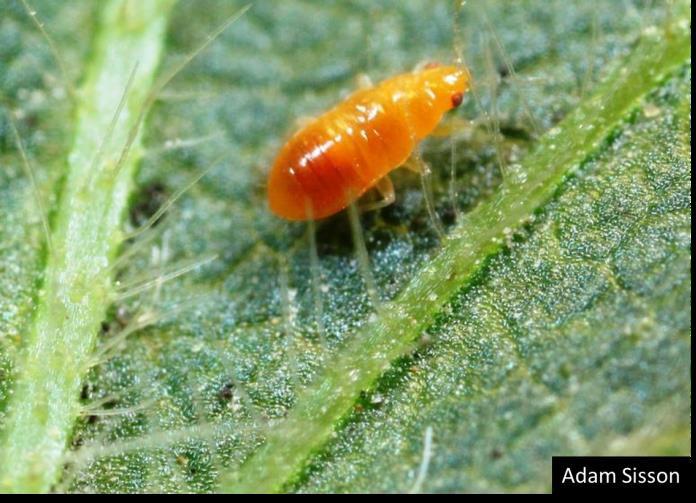Sampling for Orius
A study indicated that in soybean, O. insidiosus oviposit their eggs most frequently in leaf petioles and in the upper soybean canopy. Increased populations and inflight activity of adults have been reported on soybean foliage during flowering. Orius adults and nymphs search soybean blossoms, which are known to harbor flower thrips. Because soybean blossoms are located at bases of petioles, adult O. insidiosus are likely to pass over plant petioles when moving between blossoms and leaflets. This may explain why there is greater oviposition in petioles. Additionally, adult females may preferentially search the upper trifoliate for soybean thrips, which would account for greater concentration of their eggs in the upper soybean plant strata. Thus, if sampling for Orius, it may increase sampling efficiency to sample the upper plant canopy. Orius adults and older nymphs are easy to see in crop flowers such as cucumber and pepper flowers, where they are feeding on thrips and pollen. Adults and younger stages can be found also on leaves and along stems, but are more difficult to detect in these plant areas. Use of a headband magnifier or hand lens will help with their detection and identification. One could remove flowers from plants and shake them on a white paper to determine Orius presence especially if these flowers are harboring thrips.
Do Orius play a role in protecting agronomic crops?
Predation on European corn borer (ECB) and corn earworm (CEW) in corn. The ECB and CEW are important corn pests. The ability of O. insidiosus to search for, find, and destroy ECB and CEW eggs was investigated. Orius insidiosus was noted searching in corn silks first, followed by corn leaves but not in the tassel. Interesting enough, expected areas of highest CEW and ECB egg densities are silks and leaves, respectively. Orius insidiosus is an important natural enemy of CEW in corn, cotton and sorghum. A study conducted in western Maryland, revealed ECB larvae sustain high mortality in field corn and that O. insidiosus was the most important predator of ECB larvae in western Maryland. Their population peak coincides with corn pollen-shedding and silking; during which, they feed on second-generation ECB larvae and corn pollen. Therefore, successful biological control of ECB larvae by O. insidiosus is linked to arthropod prey and corn pollen.
Predation on thrips and soybean aphids in soybean. Orius insidiosus adults and nymphs are common in soybean fields (Fig. 4). Its population dynamics in soybean fields have been linked to thrips population levels and soybean flowering. Nymphs and adults eat soybean aphids in the field. Experimental findings suggest that under certain conditions, O. insidiosus can effectively suppress aphid population growth and that they may be key factors influencing aphid population dynamics in soybeans in some areas within the US. In addition to soybean aphids, soybean thrips are believed to be one of the more important thrips prey of O. insidiosus in soybean. It is believed that soybean thrips serve as an important prey resource for O. insidiosus in soybeans and may be important in sustaining O. insidiosus populations before the arrival of soybean aphids. Orius insidiosus is known to feed on eggs and 1st instar green cloverworm as well.
Do Orius have weak links?
Because of their small size, Orius are vulnerable to predation and being eaten by competitors/predators that utilize the same prey, which is known as intraguild predation. A number of generalist predators, particularly spiders, lace wings and other predaceous true bugs use Orius as prey. Additionally, their minute size limits their ability to thrive on plants with abundant leaf hairs. Leaf hair density was shown to have a significant impact on their longevity (how long they live) and fecundity (how many eggs they lay during a lifetime). When plant leaf hairs were thinly dispersed or sparse, O. insidiosus could reach the leaf’s surface more readily. Their small size limits the number of prey that they can successfully attack. For example, no stages of O. insidiosus could feed on green cloverworm beyond the 2nd instar. Additionally, Orius effectiveness as predators may be reduced by environmental factors such as weather and intraspecies contact among themselves.
Pesticides have been shown also to have a negative impact on Orius. Following a study, several insecticides were classified as harmful or slightly harmful to O. insidiosus; and in another study, the acute and sub lethal toxicity of 14 pesticides was tested on Orius laevigatus adults under laboratory conditions. Results showed that pesticides greatly differed in their toxicity, in terms of lethal and sub lethal effects, as well as in their persistence. In particular, abamectin was the most noxious and persistent, and was classified as harmful up to 14 d after treatment, Fig. 4. Orius nymph on soybean. Iowa State University, Bugwood.org. causing almost 100% mortality. Taken as a whole, the study demonstrated that side effects of pesticides can vary greatly depending upon pesticide chemical family and type. In addition, several biopesticides were highly toxic to O. laevigatus. Spinosad was very toxic with persistence proving to be relatively high and most effects were still observed when predators were exposed to 7- day old residues. These results matched those of previous studies, which assessed side effects of spinosad on O. insidiosus and O. laevigatus. It was unclear why O. laevigatus was negatively affected by spinosad in the study. It was suggested that its omnivorous behavior which allows it to feed on plants also could have resulted in O. laevigatus receiving greater amount of toxins than if consuming only spinosad-contaminated prey.
A study was conducted in which corn plants were twice sprayed at 3-day intervals during tasseling to evaluate effects of chlorpyrifos on ear damage by corn earworm and their associated natural enemies. Orius abundance decreased 21 days after insecticide application. This response was expected because Orius tends to forage corn tassel during pollination, which could expose them to insecticide sprays. In addition to Orius, insecticide sprays affected populations of several other predators found on the corn foliage. Orius may forage more on crops such as corn, which could lead to more contact with insecticide and thus, higher mortality.
Does Bt have an effect on Orius?
The development of Bt crops has led to a reduction of insecticide sprays required to manage crop pests, especially in agronomic crops. Still, there are concerns regarding the impact of Bt crops on biological control agents. This is especially important for omnivorous predators such as Orius, which can consume Bt directly and indirectly by feeding on Bt plant material or prey that has ingested Bt protein, respectively. However, several studies have shown that Orius abundance is not affected by Bt crops, and that feeding on Bt crops or prey that has fed on Bt crops has no negative impact on Orius species studied. For example, the ingestion of Bt protein by the predator, Orius majusculus via plant leaves, pollen or prey that fed on Bt plant material had no negative effects on its survival, development, fecundity (how many eggs they laid) and fertility. Similarly, there was no effect on O. insidiosus for consuming caterpillars that ingested Bt protein. In fact, some researchers have described occasional population density increases in Orius spp. in Bt maize and suggested that this could be related to their preference for ears and silks free from lepidopteran feeding. Additionally, O. majusculus fecundity was increased when they fed on Bt plant material, and nymphal development was shortened when nymphs were fed on Bt-containing spider mites.
Can Orius numbers be increased in the field? Several practices can be used in the field, to conserve and maximize the natural presence of beneficial insects. One practice to conserve Orius populations within crop fields is to avoid the use of broad-spectrum insecticides. However, as indicated earlier, insecticides other than broad spectrum including some biopesticides can have a negative impact on Orius survival and population density. In conservation biological control programs, provision of required resources (e.g., shelter, food and oviposition sites) can be achieved by growing insectary plants. This can be especially important for omnivorous predators such as Orius that feed on arthropod prey and plant material, and where the availability of plant resources play a significant role in their conservation. For example, pollen resources can allow Orius to survive periods of prey scarcity. As such, growing flowering plants in close proximity to crop fields where pest control is needed will provide nectar and pollen resources that can attract Orius and other beneficials to the area. A study found that Black Pearl pepper pollen can enhance life history traits of O. insidiosus in several ways: increase female longevity, decrease nymphal development time, increase female size and increase predator abundance on flowering peppers. These results indicate that pollen from the Black Pearl pepper plant could be a valuable tool for increasing O. insidiosus abundance. However, whether this would result in greater biological control efficacy is still unknown. Similarly, results from another study showed that alyssum (Lobularia maritima) can provide resource subsidies for O. majusculus during times when prey are scarce in the field. Therefore, insectary plants could be used to help establish Orius populations in fields before crops are planted. The addition of prey within insectary plants could further ensure early population development of Orius until targeted insect pests colonize the crop field.
Summary
Generalist predators of the genus Orius (minute pirate bugs) feed on a variety of prey. They are voracious predators in all their active life stages, which means they can be released at different developmental stages. As biological control agents, minute pirate bugs display some useful characteristics in terms of their establishment in crops prior to pest arrival and their ability to tolerate reductions in prey availability. More importantly, for some soybean producers, there is increasing evidence that the insidious flower bug, Orius insidiosus helps prevent soybean aphid outbreaks. However, its population dynamics appear to be more strongly linked to that of thrips. For example, during early-season before soybean aphid arrives, colonization by thrips and Orius reproductive response to thrips helps to promote high numbers that can exert significant mortality on soybean aphid populations. Orius are used worldwide for controlling different thrips pests, but will attack many soft-bodied arthropods such as aphids, whiteflies, mites, young butterfly and moth larvae, leafhopper nymphs and small arthropod eggs. Orius insidiosus is one of the most commonly used Orius species in biological control programs worldwide, especially for thrips suppression. This preference may be driven more by the predator and prey having overlapping habitats than an inherent prey preference. Even so, species of Orius are effective thrips predators and are thought to have a preference for flower thrips. Orius predators live concealed in the same habitat as thrips, making thrips an easy target. Another factor that makes Orius a desirable insect in biological control programs is the ease of being mass reared. Though, releases of Orius are usually undertaken to control thrips on plants in greenhouses, releases on field crops have been carried out successfully.
